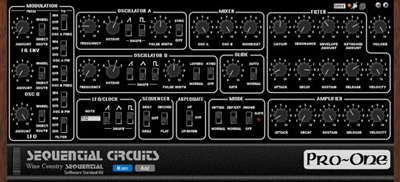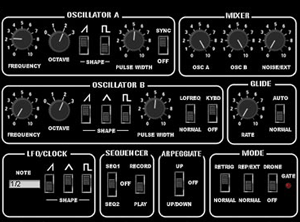|
|
|
|
|
|
Review: Creamware Pro One
By Manuel
Clement
(February 29, 2004)
 Back to the
Articles list Back to the
Articles list
Summary: 1:1 digital model of the classic Pro One synthesizer for
Creamware DSP systems
Manufacturer: Creamware
Compatibility: PC or Mac equipped
with a Creamware DSP system
Price: 198 EUR

You guys know I liked the Minimax, also by Creamware; today I am taking a
look at the Pro One, named and modeled after the cult analog
synthesizer by Sequential Circuits. You can find a ton of useful
information about the original Pro One synthesizer on this page. Since this device is well-known I will
try to focus on the few differences, and of course the
sound.
As usual I will try to give you guys stuff to
listen to as I go through my review, so you can get a good feel of
what I am writing about. This way you can also disagree with my
likes or dislikes, and have your own opinion. I want to "share" what
I am observing and playing with.
First Look
I was expecting a very clear user interface,
all parameters exposed, no modes or pages to scroll: the Pro One is
*clearly* all this. Back in the day they definitely made things
easy.
The interface has 2 pages available: "main" and "add".
Main is basically where you do most of the work, from Modulation to
Oscillator (A and B), Mixer, etc. Add is where the effects sections
and misc. parameters go, organized in sections such as
Chorus/Flanger and Delay.

Hands-On Pro One
Let's build a song! I thought I would
start with a bass line. I'll improvise, see what kind of feel or
groove I get into, and the rest of the track will build up from
there.
I am not a huge fan of presets... For some reason most
of the presets I hear on synthesizers are *very* different from the
sounds I want, so I quickly look for the "Init" preset to start a
new sound from scratch.
I quickly notice how FULL, THICK and
LOUD the Pro One is. Beyond my expectations, the thing SCREAMS out
of my speakers, takes a front-row seat in the mix without asking
permission - THAT's my kind of synth! I am starting to like it and
see how it could be used in my productions to contrast with the
Minimax's softer sound.
Now guys, let me warn you that I'm
not going to try to produce a hit in this review, so when you listen
to these recordings remember I am "just" trying to see what the Pro
One has in its guts, a fashion show if you will, with exagerated
glides and all. and hey maybe you'll like it anyways!.
As I noticed with the Minimax, sounds don't take long to be
shaped as the old school interface exposes every parameter of the
machine on its front panel. I play with the oscillator section,
noticing a percussive grain with very edgy highs. For the bass I
head for the filter (Low Pass) and cut down quite a bit, letting
only the bass stuff out. The deep bass is taking shape, and I
quickly capture a MIDI sequence in Cubase on the keyboard, tracking
it to an audio track.
Listen to the bass alone: pro-one_bass.mp3

The bass is
nice but I really need to hear some bumping drums to get a feel for
the next things to add. I quickly drag a few boring drum WAVs and
tweak them a bit: detuning and EQ for the kick, some much needed
"chopping" for the snare, and finally a bit of compression using
VINCO. My drums sound more like what I want. I tap in a beat,
nothing fancy but it's enough to see how the Pro One bass sits
along.
I have images of break dancers coming to my mind, and
knowing that the Pro One has a very edgy percussive sound, I think
the track should have some electro-beat taste to it, with robotic
blips and leads cutting through. Time to put together a tricked out
lead sound. While Cubase loops my drums and bass, I enable the Glide
feature and start playing with it, letting the Pro One slowly
connect the various tones. As I play with the 2 oscillators I
finally get to the sound i want. It reminds me of a large wind
instrument with both tons of low and high frequencies.
Listen
to the lead track by itself: pro-one_lead.mp3
At this point, I can't
resist adding some electronic BLIP sounds. The Pro One's sound will
be perfect for this job. Starting from the lead patch I just built,
I dial a few new parameters, shortening the sustain, decay and
quickly get to the sound I want. I sprinkle just a little bit here
and there, not too much.
Listen to the blips track alone: pro-one_blips.mp3
I put all the pieces
together and saved out a *rough* mix. Again, this isn't your
expert-mastered track, so adjust your system to hear
everything.
Listen to the full piece:pro-one_full.mp3
Note how fast sound
programming was back in the day: each button has ONE function, there
is no menu to navigate through each time you want to sculpt your
sound the way you want.
Performance and DSP usage
To build this tune I only
needed 1 voice (like the original) however you can turn the Pro One
into a polyphonic instrument by choosing the number of voices you
want. On the creamware site I saw this info: "As a consequence of
the highly complex algorithms used in the Sequential Circuits™
Pro-One, its polyphony is limited. As a rough guide: on a 3-DSP card
you can expect to have 4 voices, on a 6-DSP card 8 voices, and on a
15-DSP card 16 voices". After testing the Pro One with various
settings, I found this statement to be true. The card I am using is
a Pulsar 2 (6 DSP) and it worked as expected. One thing I like to
point out is: "quality, not quantity".
Conclusion
This is one *phat* synthesizer! Great sound,
even though I am personally more a Minimoog kind of guy, Pro One is
extremely handy when you need this screaming, percussive
sound.
-mano
 Read more
Exclusive FP Features Read more
Exclusive FP Features
|
|
|
|
| |
|
Auctions!
Hot Music Gear
Exclusive FP Features

Mano reports about Dave Smith's new synthesizer, the
Poly Evolver Keyboard. This is part 1: the first few minutes with
the synth, on video

David Gibb explores the Nuo-5 mixer from Ecler.
Check out the full review of the beast, with pictures and video!

MMhhhh molded HardBody shell,
velvet-lined interior... Mano looks at Slappa's CD/DVD cases.
 More
Features More
Features
|
| |